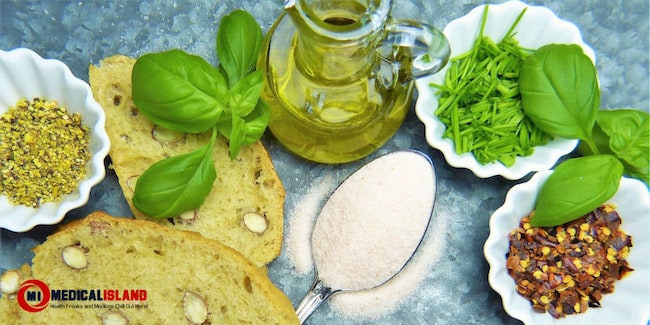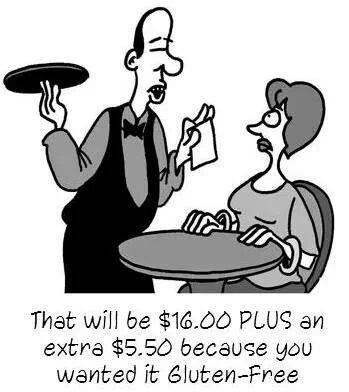Did you know that nearly one in 1,000 people have a wheat allergy and that one in every 100 people have celiac disease? Both of these conditions cause people to remove gluten entirely from their diet to aid in digestive and heart health. But did you know that one in five adults are currently eating gluten-free diets despite less than 0.7 percent of people needing to eat gluten-free? That means that 20 percent of people in the U.S. eat gluten-free when less 1 percent of them need to.

Why? Because eating gluten-free has transformed from a medical necessity for some to the latest food trend. The food industry has been making very calculated steps to ensure that people believe gluten to be bad for them, to be weight causing, and to lead to poor heart health.
This statement is true to some degree, as gluten can certainly cause weight gain (much like most foods), and the intake of too much of anything can cause heart health concerns. However, gluten has been miscategorized as being an unnecessary ingredient when, in fact, it is linked to reduced risks of diabetes, obesity and coronary heart disease and is necessary in the proper regulation of certain sugars and overall gut health.
This isn’t the first time food culture has changed based on the latest trend. Coconut water quickly trended in and back out of food fashion when people finally learned that most coconut water is loaded with added sugar and other unhealthy ingredients.
Certainly, many people have some form of a gluten intolerance whether it comes in the form of heartburn after bread, constipation following pasta or upset stomach after certain desserts. But it is important to understand that gluten intolerance and celiac disease are very different things. Gluten intolerance can lead to minor symptoms of discomfort, but celiac disease can manifest in many complicated outcomes including severe skin rashes and malnutrition.
Gluten-free dieting has become such a popular fad in eating that more and more products are being designed for people with gluten intolerance. You can now find products like bread, pasta, cookies and even protein powder that are free from gluten. What these gluten-free products don’t make obvious is what is packed inside of the treats to replace the missing gluten.
The most common substitutions for flour in gluten-free products are ingredients like rice flour, potato flour, cornstarch and tapioca starch. That means that you are getting rid of the gluten in food only to replace it will fatty carbs that lead to increased weight gain.
Sugar often becomes a replacement ingredient as well, leading to cases of high blood sugar and increased risk for diabetes. Certain oils like vegetable and sunflower are often marked as gluten-free promoting a healthy lifestyle when really they are very high in omega 6 fatty acids that lead to excess weight gain.
Certain studies have suggested that eating gluten-free when you don’t have celiac disease or wheat allergies can actually be harmful because key nutrients found in gluten are now missing from your body. Some of the ways that gluten can be beneficial to your body include lowering your risk for type 2 diabetes and heart disease, as well as reduced risk of colorectal cancer.
Don’t get me wrong, removing certain types of gluten from your diet can surely be beneficial, but consider your health before completely removing it from your diet. It’s also smart to speak with your doctor before taking the extra step to remove any ingredient from your diet, whether it’s gluten, caffeine or sugar.
To help you get started in the right direction for proper gluten consumption, here is a list of common ingredients that can used to help lower your gluten intake without getting rid of it entirely.
Fruit
Yes, most fruit is naturally free from gluten, but gluten can sneak into your fruit, especially if you are growing it fresh from your garden. Whether you buy your fruit from the store or pick it from your backyard, be sure to rinse produce thoroughly to remove any external gluten source. Remember, fruit is high in sugar, so make sure you are maintaining a healthy intake of this exceptionally sweet treat as well.
Proteins
Ingredients like beans, lentils and hummus make for terrific gluten-free and gluten-low meals. Unlike meat, these replacement ingredients are often high in fatty acids that can help contribute to weight gain, so it’s important to eat these things in moderation. They also contain a lot of protein that will help nourish your body and combat hunger.
Grains
Though gluten is a protein found in grain, there are a number of grains that do not contain any gluten or contain very low levels of gluten. These include quinoa, amaranth, buckwheat and brown rice. These grains are boring on their own, but jazz them up with a delicious sauce and some vegetables and complete your meal with a protein like black beans. Your tummy will be happy to be full and happy to be full of delicious foods.
Vegetables
Like fruit, vegetables are naturally free from gluten, however, there are certain vegetables that help promote lean muscles and overall body health like winter squash, corn and sweet potatoes. These veggies are really sweet and filling, so they help cut your cravings for sugar and make you feel fuller, longer.
